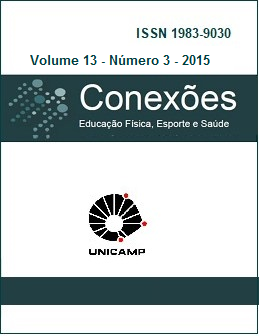Resumen
La cooperación entre los compañeros de equipo y la forma en que se ejecuta es de
fundamental importancia para la comprensión de los procesos sociales dentro de un grupo
de trabajo. En el caso particular del deporte, la cooperación es inevitable en los deportes
colectivos. Métricas recientes basados en la teoría de grafos proporcionan un nuevo
enfoque capaz de aprovechar la información recopilada cuantitativamente. Por lo tanto,
este ensayo tiene como objetivo dar a conocer las posibilidades y técnicas de análisis de
redes sociales en el caso específico del deporte y como tal enfoque puede mejorar los
estudios sociales. Análisis de las propiedades de la red de cooperación, así como métricas
para determinar la dependencia entre los compañeros y la centralidad de lo individuo se
presentan y discuten en este trabajo.
Citas
LUSHER, D., ROBINS, G., KREMER, P. The application of social network analysis to team sports. Measurement in Physical Education and Exercise Science, v. 14, n. 4, p. 211–224, june 2010.
CLEMENTE, F.M. et al. Using network metrics to investigate football team players ’connections: a pilot study. Motriz, Rio Claro, v . 20, n. 3, p. 262-271, set. 2014.
CLEMENTE, F.M. et al. Using network metrics in soccer: a macro-analysis. Journal of Human Kinetics, v. 45, p. 123–134, july 2015.
LIGHT SHIELDS, D. L. et al. The relationship between leadership behaviors and group cohesion in team sports. Journal of Psychology, v. 131, n. 2, p. 196–210, ago. 1997.
CARRON, A. V.; BRAY, S. R.; EYS, M. A. Team cohesion and team success in sport. Journal of Sports Sciences, v. 20, n. 2, p. 119–26, feb. 2002.
LOUGHEAD, T. M.; HARDY, J. An examination of coach and peer leader behaviors in sport. Pshychology of Sport and Exercise, v. 6, n. 3, p. 303–312, mar. 2005.
MORGAN, P. B. C., FLETCHER, D.; SARKAR, M. Defining and characterizing team resilience in elite sport. Pshychology of Sport and Exercise, v.14, n. 4, p. 549–59, apr. 2013.
FRANSEN, K. et al. The myth of the team captain as principal leader: extending the athlete leadership classification within sport teams. Journal of Sports Sciences, v. 32, n. 14, p. 1389-1397, dec. 2014.
ABBOTT, A. Of time and space: the contemporary relevance of the chicago school. Social Forces, v. 75, n. 4, p. 1149–82, dec. 1997.
MORENO, J. L. Who shall survive? foundations of sociometry, group psychotherapy and socio-drama. Oxford: Beacon House, 1953.
KNOKE, D.; YANG, S. Social network analysis. London: SAGE, 2008.
BARNES, J. A.; HARARY, F. Graph theory in network analysis. Soc Networks, v. 5, p. 235–44, apr. 1983.
PAVLOPOULOS, G. A. et al. Using graph theory to analyze biological networks. BioData Min., v. 4, n. 1, p. 10, mar. 2011.
HORVATH, S. Weighted network analysis: Applications in Genomics and Systems biology. New York: Springer, 2011.
HAGGARTY, S. J.; CLEMONS, P. A.; SCHREIBER, S. L. Chemical genomic profiling of biological networks using graph theory and combinations of small molecule perturbations. Journal of the American Chemical Society, v.125, n. 35, p.10543-10545, apr. 2003.
BURT, R. S.; KILDUFF, M., TASSELLI, S. Social network analysis: foundations and frontiers on advantage. Annual Review of Psychology, v. 64, p. 527–547, july 2013.
HAMMOND, D. K.; VANDERGHEYNST, P., GRIBONVAL, R. Wavelets on graphs via spectral graph theory. Applied and Computational Harmonic Analysis, v. 30, n. 2, p.129-150, june 2011.
PRELL, C.; HUBACEK, K.; REED, M. Stakeholder analysis and social network analysis in natural resource management. Society & Natural Resources, v. 22, n. 6, p. 501-518, 2009.
LEVI-STRAUSS, C. The elementary structures of kinship. Boston, Beacon, 1969.
PARK, R. The concept of social distance. Journal of Applied Sociology, v. 8, p. 339-344, 1924.
GRUND, T. U. Network structure and team performance: the case of english premier league soccer teams. Social Networks, v. 34, n. 4, p. 682–690, sept. 2012.
WELLMAN, B.; BERKOWITZ, S. D. Structural analysis in the social sciences 2 social structures: a network approach. Cambridge: Cambridge University, 1988.
OTTE, E.; ROUSSEAU, R. Social network analysis: a powerful strategy, also for the information sciences. Journal of Information Science, v. 28, n. 6, p. 441–453, jun. 2002.
WETHERELL, C.;, PLAKANS, A.; WELMANN, B. Social network, kinship, and community in Eastern Europe. Journal of Interdisciplinary History, v. 24, p. 639-663, oct. 1994.
TICHY, N. M.; TUSHMAN, M. L.; FOMBRUN, C. Social network analysis for organizations. Academy of Management Review, v. 4, n. 4, p. 507–519, 1979.
WASSERMAN, S.; FAUST, K. Social network analysis: Methods and applications. New York: Cambridge University, 1994.
SCOTT, J. Social network analaysis. London: SAGE, 2000.
HANNEMAN, R. A.; RIDDLE, M. Introduction to social network methods. Riverside, University of California, 2005.
GRÉHAIGNE, J. F.; BOUTHIER, D.; DAVID, B. Dynamic-system analysis of opponent relationship in collective actions in football. Journal of Sports Sciences, v. 15, n. 2, p.137–149, feb. 1997.
WATTS, D. J.; STROGATZ, S. H. Collective dynamics of “small-world” networks. Nature. v. 393, p. 440–442, may 1998.
RAVASZ, E. et al Hierarchical organization of modularity in metabolic networks. Science, v. 297, n. 5586, p.1551-1555, nov. 2002.
COUCEIRO, M. S.; CLEMENTE, F. M.; MARTINS, F. M. L. Toward the evaluation of research groups based on scientific co-authorship networks : the robocorp case study. The Arab Gulf Journal of Scientific Research, v. 31, n. 1, p. 36–52, dec. 2013.
KALAMARAS, D. Social networks visualizer (SocNetV): social network analysis and visualization software. Social Networks Visualizer. Disponível em: http://socnetv.sourceforge.net, 2014.
O periódico Conexões: Educação Física, Esporte e Saúde utiliza a licença do Creative Commons (CC), preservando assim, a integridade dos artigos em ambiente de acesso aberto.


